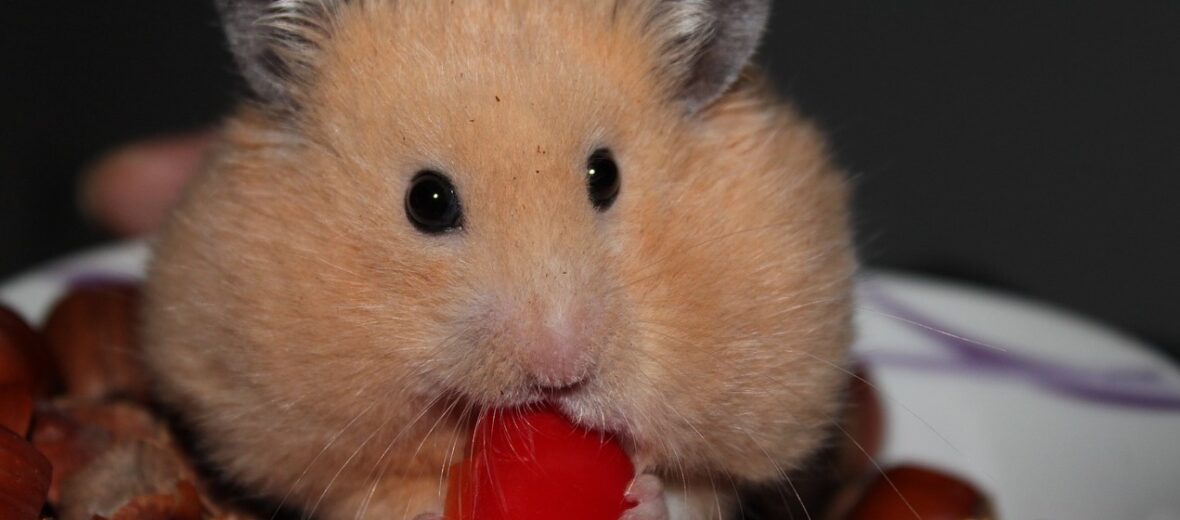
There are approximately 24 known hamster species. They can be found in Asia, Europe, and Northern Africa. These rodents prefer deserts, sand dunes, open plains, and agricultural fields. Hamsters also have been domesticated and are popular pets around the world. The Roborovski is the smallest known hamster species and the Syrian hamsters are the largest. Many species are listed as Least Concern, but there are some listed as Near Threatened and even Critically Endangered by the IUCN.
First the Stats…
Scientific name: Cricetinae
Weight: Up to 15 ounces
Length: Up to 7 inches
Lifespan: Up to 4.5 years
Now on to the Facts!
1.) Syrian hamsters, who live in hot and dry climates will store gathered fruit in their burrows for the winter months. However, the fruit does what fruit does… it ferments. This produces alcohol. In order to be able to safely consume this alcohol enriched fruit, they have evolved larger livers and a higher tolerance for alcohol.
2.) They are crepuscular (active at dawn and dusk). Contrary to popular belief that they are nocturnal (active at night).
3.) Tunnels, aka burrows, can reach upwards of 6 feet deep!
4.) Wild hamsters hibernate in the winter.
5.) Their cheek pouches are so large that when a female feels threatened she will tuck her babies in her cheek pouches and scurry off to the safety of her burrow.
But wait, there’s more on the hamster!
6.) They get their name from the German word “hamstern”, which means to hoard. Appropriate name, considering that’s what they love to do.
7.) Only 5 species make appropriate pets: Campbell’s dwarf, Chinese, Roborovski (aka Robo), Russian dwarf, and Syrian.
Did you know…?
Being solitary, most hamsters, if not from the same brood, will fight to the death if placed together!
8.) While utilizing their wheel, a hamster can run up to 5.5 miles in a single night!
9.) A female’s gestation (pregnancy) period lasts only 16 – 30 days. This is among the shortest of all mammalians.
10.) Females can get pregnant the same day they give birth.
But wait, there’s still more on the hamster!
11.) It has been documented that females will eat their young or even end their pregnancy if resources are scarce.
12.) Seeing as you cannot spay or neuter a female or male, the only way to prevent pregnancies is to keep the boys and girls apart. Put them together and you’ll have a whole bunch of babies in no time.
Did you know…?
Contrary to other hamster species, dwarf hamsters are actually social and enjoy the company of others. Fights are less likely to break out amongst this species.
13.) The Syrian is also known as a teddy bear hamster. This is due to it’s peaceful nature and cuddly appearance.
14.) Young hamsters are born altricial (blind and helpless). After 3 – 4 weeks, they are weaned and able to forage for themselves.
15.) They may have bulbous eyes, but these critters have very poor eyesight. They are nearsighted and colorblind.
But wait, there’s even more on the hamster!
16.) It has been documented that Roborovski hamsters have run up wards of 100 miles in a single night!
17.) With poor eyesight, these critters depend on their sensitive whiskers and sense of smell to help them navigate through their world.
18.) If you spook a hamster, they will scream. But please don’t do this.
19.) Like all rodents, their teeth never stop growing. Therefore they must constantly gnaw on tough substances, like twigs and such to wear down their teeth. Else they’ll over grow and they won’t be able to eat.
20.) If a primary tooth breaks, the tooth next to it will start growing in to take the lost tooth’s place.
But wait, there’s just a little more on the hamster!
21.) Hamsters are polygynandrous (males and females mate with multiple partners).
22.) Females have up to 8 pups each litter and they breed up to 3 times per year!
23.) Birds of prey, foxes, dogs, cats, and badgers (to name a few) all prey on wild hamsters.
24.) These lovable creatures eat hay, grains, fruits, vegetables, and tubers.
Now a Short Hamster Video!
Be sure to share & comment below! Also, check out the Critter Science YouTube channel. Videos added frequently!
Want to suggest a critter for me to write about? Let me know here.



